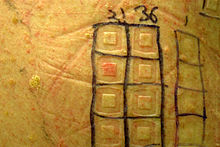Mazzotti reaction
The Mazzotti reaction represents a complex of symptoms that develop under the therapy of a roundworm disease v. a. adjusts or can adjust with the anthelmintic diethylcarbamazine (DEC). It was first described by the Mexican parasitologist Luigi Mazzotti (1900–1971), who discovered it in 1948.
Symptoms and pathogenesis
As a result of anthelmintic therapy, the worms die in the host's body. During this process, parasitic antigens increasingly reach the host organism and trigger an (excessive) immune reaction there. The symptoms of the reaction can therefore usually be assigned to the allergic group of forms:
- Wheal formation ,
- Hypotension with reactive tachycardia ,
- and edema formation
In addition, there are general symptoms such as fever , swollen and tender lymph nodes , joint and abdominal pain . In extreme cases, the Mazzotti reaction can extend to anaphylactic shock , which is acutely life-threatening. The reaction usually develops within 7 days of the start of therapy, whereby the extent of the symptoms seems to correlate with the parasite infestation density.
trigger
Mazzotti described the response in treating river blindness with diethylcarbamazine. But other antiparasitic active ingredients can also be used as triggers, such as B. ivermectin , praziquantel and albendazole . Other parasitic diseases that can cause a Mazzotti reaction during therapy are infestation with pair leeches or dwarf threadworms . The occurrence of the symptom complex has also been described in the ivermectin treatment of scabies .
Mazzotti test
Since the Mazzotti reaction occurs very often during DEC therapy for river blindness, this fact can be used diagnostically:
The technically simpler - albeit riskier - option is similar to the diagnosis ex juvantibus . The patient receives an oral DEC dose; If it then shows the typical symptoms of the Mazzotti reaction, one can safely assume that it is infected by Onchocera volvulus or other filariae .
The more elegant shape is a variant of the patch test . In contrast to the usual test, no allergen is applied to the patient's skin, but DEC is applied to the skin and left there under an aluminum cap. The active ingredient kills the larvae located under the aluminum plate in the skin and there is a locally limited immune reaction to the pathogen components released. Dermatologically , a positive test can also be found here. a. read from the formation of erythema , eczema , papules or vesicles . The possibility of a systemic anaphylactic reaction with this type of test is extremely small.
In the case of positive evidence, both variants offer the option of treating the infestation with other drugs (if available), which have a significantly lower risk of a Mazzotti reaction.
therapy
Since the cause is an overreaction of the immune system, immunosuppressive glucocorticoids such as, for example , are suitable for (preemptive) therapy or prophylaxis . B. Prednisone . If the symptoms of shock develop, the patient should be treated according to anaphylaxis ( catecholamines , volume therapy ).
Similar clinical pictures
One of the pathophysiological explanations for the Jarisch-Herxheimer reaction , the z. B. can occur in penicillin G therapy of syphilis is based on a similar pathomechanism. Here also released pathogen components are suddenly to an overreaction of the immune system with massive interleukin production predispose that can lead up to shock.
In the treatment of (cystic) echinococcosis , surgical procedures can lead to the opening of a pathogen-containing cyst, from which the parasite components can spread into the body and trigger a systemic allergic reaction.
Individual evidence
- ^ Mazotti reaction . Retrieved December 22, 2014.
- ^ SJ Ackerman, GM Kephart, H. Francis, K. Awadzi, GJ Gleich, EA Ottesen: Eosinophil degranulation. An immunologic determinant in the pathogenesis of the Mazzotti reaction in human onchocerciasis. In: The Journal of Immunology. 144, No. 10, 1990, pp. 3961-3969, PMID 2332637 .
- ^ Bradley G. Olson et al: Mazzotti Reaction After Presumptive Treatment for Schistosomiasis and Strongyloidiasis in A Liberian Refugee . In: The Pediatric Infectious Disease Journal . 25, No. 5, May 2006, pp. 466-468. doi : 10.1097 / 01.inf.0000217415.68892.0c .
- ^ Toshiki Ito: Mazzotti reaction with eosinophilia after undergoing oral ivermectin for scabies. In: The Journal of Dermatology . 40, No. 9, 2013, pp. 776-777, doi: 10.1111 / 1346-8138.12243 .
- ↑ https://web.stanford.edu/class/humbio103/ParaSites2006/Onchocerciasis/Diagnosis.html
- ^ Kilian Hd: The use of a topical Mazzotti test in the diagnosis of onchocerciasis. In: Tropical medicine and parasitology: official organ of Deutsche Tropenmedizinische Gesellschaft and of Deutsche Gesellschaft fur Technische Zusammenarbeit (GTZ). 39, No. 3, 1988, pp. 235-238, PMID 3194667 .
- ^ WR Brieger et al: The effects of ivermectin on onchocercal skin disease and severe itching: results of a multicenter trial. In: Tropical Medicine & International Health. 3, No. 12, 1998, pp. 951-961, doi: 10.1046 / j.1365-3156.1998.00339.x .
- ^ Bradley G. Olson, Joseph B. Domachowske: Mazzotti Reaction After Presumptive Treatment for Schistosomiasis and Strongyloidiasis in A Liberian Refugee: In: The Pediatric Infectious Disease Journal. 25, No. 5, 2006, pp. 466-468, doi: 10.1097 / 01.inf.0000217415.68892.0c .
- ↑ Johannes Ring et al .: Guideline for acute therapy and management of anaphylaxis. In: Allergo Journal International. 23, No. 3, 2014, pp. 96–112, doi: 10.1007 / s40629-014-0009-1 ( PDF ( Memento of the original from December 22, 2014 in the Internet Archive ) Info: The archive link was inserted automatically and not yet Checked. Please check the original and archive link according to the instructions and then remove this note. ).
- ↑ V. Vidal, IG Scragg, SJ Cutler, et al .: Variable major lipoprotein is a principal TNF-inducing factor of louse-borne relapsing fever . In: Nat Med . 4, No. 12, December 1998, pp. 1416-1420. doi : 10.1038 / 4007 . PMID 9846580 .
- ↑ G. Kaplanski, B. Granel, T. Vaz, JM Durand: Jarisch-Herxheimer reaction complicating the treatment of chronic Q fever endocarditis: elevated TNFalpha and IL-6 serum levels . In: Journal of Infection . 37, No. 1, July 1998, pp. 83-84. doi : 10.1016 / S0163-4453 (98) 91120-3 . PMID 9733392 .
- ^ KH Park, SI Jung, HC Jang, JH Shin: First successful puncture, aspiration, injection, and re-aspiration of hydatid cyst in the liver presenting with anaphylactic shock in Korea . In: Yonsei Med J. . 50, No. 5, October 2009, pp. 717-720. doi : 10.3349 / ymj.2009.50.5.717 . PMID 19881979 . PMC 2768250 (free full text).


